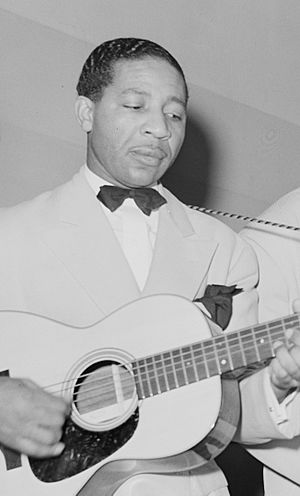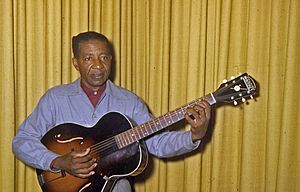Lonnie Johnson (musician) facts for kids
Alonzo "Lonnie" Johnson was a famous American musician. He played blues and jazz music. He was a great singer, guitarist, and violinist. Many people say he was the first to play an electric violin! He was born in 1899 and passed away in 1970.
Contents
Lonnie Johnson's Life Story
Early Musical Journey
Lonnie Johnson was born in New Orleans, Louisiana. He grew up in a family full of musicians. As a child, he learned to play the violin, piano, and guitar. He also learned other instruments like the mandolin. But he mostly focused on the guitar throughout his career.
Lonnie once said, "There was music all around us." He added that in his family, "you'd better play something." Even if it was just banging on a tin can!
In 1917, Lonnie joined a music show that toured England. He came back home in 1919. Sadly, he found that most of his family had died. This was due to a serious illness that spread around the world. Only his brother James survived.
Lonnie and James moved to St. Louis in 1921. They performed together as a musical duo. Lonnie also worked on riverboats. He played in orchestras led by Charlie Creath and Fate Marable.
Lonnie married Mary Johnson in 1925. Mary also became a blues singer. She recorded music from 1929 to 1936. Lonnie and Mary had six children.
Rising to Fame in the 1920s and 1930s
In 1925, Lonnie won a blues contest in St. Louis. The prize was a recording contract with Okeh Records. Between 1925 and 1932, he recorded about 130 songs for Okeh. Many of these songs sold very well. This made him one of Okeh's most popular artists.
He went to New York to record with famous blues singers. These included Victoria Spivey and Alger "Texas" Alexander. He also toured with Bessie Smith, a very popular singer.
In December 1927, Lonnie recorded in Chicago. He was a guest artist with Louis Armstrong and His Hot Five. He played on songs like "I'm Not Rough" and "Hotter Than That." "Hotter than That" is very famous. It showed off the New Orleans style of jazz.
Lonnie was often invited to play with other jazz groups. In 1928, he recorded with Duke Ellington for Okeh. He also played with a group called the Chocolate Dandies.
Lonnie was a pioneer in guitar solos. He played solos on his 12-string guitar. His style influenced future jazz guitarists. These included George Barnes and Django Reinhardt. He made the guitar an important voice in jazz music. He was also great at instrumental songs. He recorded some with jazz guitarist Eddie Lang.
Many of Lonnie's songs showed the challenges faced by African Americans. Songs like "Racketeers' Blues" talked about social conditions. His music showed he understood people's heartaches. Lonnie believed this was the true meaning of the blues.
After touring with Bessie Smith in 1929, Lonnie moved to Chicago. He recorded with pianist James P. Johnson. But during the Great Depression, it was hard to make a living from music. He had to work outside of music for a while. He even worked in a steel mill.
In 1932, he moved to Cleveland, Ohio. He lived there for the rest of the decade. He played on radio shows. He also performed with the band for singer Putney Dandridge.
By the late 1930s, he was recording again in Chicago. He worked with musicians like Roosevelt Sykes. In 1939, Lonnie used an electric guitar for the first time. This was during a recording session for Bluebird Records. He recorded many songs for Bluebird. These included hits like "He's a Jelly Roll Baker."
Later Career and Comeback
After World War II, Lonnie changed his style to rhythm and blues. He recorded for King in Cincinnati. In 1948, he had a big hit with "Tomorrow Night." This song topped the R&B charts for seven weeks. It sold three million copies! This song was a blues ballad. It sounded different from his earlier blues and jazz music. Other songs like "Pleasing You" were also R&B hits.
In 1952, Lonnie toured England. A British musician named Tony Donegan was inspired by him. Tony even changed his name to Lonnie Donegan!
After returning to the United States, Lonnie moved to Philadelphia. He worked in a steel factory and as a janitor. In 1959, a radio DJ named Chris Albertson found him. Chris helped Lonnie record a new album called Blues by Lonnie Johnson. This brought Lonnie back into the music scene. Young people were becoming interested in folk music. Many older musicians were getting a chance to perform again.
Lonnie was reunited with Duke Ellington. He also appeared at a big folk concert. In 1961, he recorded another album with his old partner Victoria Spivey. They also performed together in New York City. In 1963, he toured Europe with the American Folk Blues Festival. He played with Muddy Waters and others. He also recorded an album in Denmark.
In 1965, Lonnie performed in Toronto, Canada. He liked the city and decided to move there. He opened his own club, "Home of the Blues," in 1966. But the club did not do well. Lonnie continued to record music and play in clubs in Canada. He also went on several tours.
In 1993, an album of Lonnie's music was released. It was called The Complete Folkways Recordings. Lonnie had been on other blues albums before. But he never had his own solo album on that label during his lifetime.
Lonnie Johnson was honored in 1997. He was added to the Louisiana Blues Hall of Fame.
Injury and Final Performance
In March 1969, Lonnie was hit by a car in Toronto. He was badly hurt. He broke his hip and had kidney injuries. A benefit concert was held to help him. Many musicians performed, including John Lee Hooker.
Lonnie never fully recovered from his injuries. He also suffered a stroke. But he was able to perform one last time. This was on February 23, 1970, at Massey Hall. He walked with a cane and sang a few songs with Buddy Guy. Lonnie received a standing ovation from the audience.
Passing Away
Lonnie Johnson passed away on June 16, 1970. A funeral was held in Toronto. But his family wanted him buried in Philadelphia. He was buried there. Later, a group helped buy a headstone for his grave.
His Musical Impact
Lonnie Johnson's early recordings were very important. He was one of the first to play guitar solos with single notes. He also used techniques like string bending. His style influenced many famous guitarists. These include Django Reinhardt and T-Bone Walker. He also influenced almost all electric blues guitarists.
One of Elvis Presley's first recordings was Lonnie's song "Tomorrow Night." Elvis's singing style in that song was similar to Lonnie's. You can hear how Lonnie's style helped shape Elvis's famous sound.
Bob Dylan also spoke about Lonnie's influence. Dylan said he was lucky to meet Lonnie Johnson. He learned a lot from watching him play. Dylan mentioned that his own song "Corrina, Corrina" was very much like Lonnie Johnson's style. Dylan also wrote that Robert Johnson, another famous blues musician, learned a lot from Lonnie Johnson. Some of Robert Johnson's songs are seen as new versions of songs Lonnie recorded.
Discography
As the Main Artist
- Lonesome Road (King, 1958)
- Blues by Lonnie Johnson (Prestige Bluesville, 1960)
- Blues & Ballads (Prestige Bluesville, 1960)
- Losing Game (Prestige Bluesville, 1961)
- Another Night to Cry (Prestige Bluesville, 1962)
- Idle Hours (Prestige Bluesville, 1962)
- Swingin' the Blues (Xtra, 1966)
- Eddie Lang & Lonnie Johnson Vol. 1 (Swaggie, 1967)
- Eddie Lang & Lonnie Johnson Vol. 2 (Swaggie, 1970)
- Mr. Trouble (Folkways, 1982)
- Tears Don't Fall No More (Folkways, 1982)
- Blues, Ballads, and Jumpin' Jazz Vol. 2 (Prestige Bluesville, 1990)
- The Unsung Blues Legend (Blues Magnet, 2000)
As a Guest Artist
- Victoria Spivey, Woman Blues (Prestige Bluesville, 1962)
- Victoria Spivey, The Queen and Her Knights (Spivey 1965)
See also
 In Spanish: Lonnie Johnson para niños
In Spanish: Lonnie Johnson para niños
- List of blues musicians
- List of jazz musicians
Relevant literature
- Simon, Julia. The Inconvenient Lonnie Johnson: Blues, Race, Identity. Penn State University Press, 2022.



